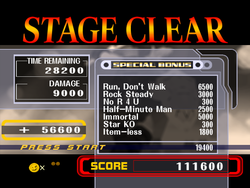Score: Difference between revisions
MHStarCraft (talk | contribs) No edit summary |
m (Inserting a link as agreed) |
||
| Line 7: | Line 7: | ||
Nearly every game mode features scores, even those that do not use them to determine victory or success. Some scores accumulate, such as the total distance each [[character]] has hit [[Sandbag]] in the [[Home-Run Contest]] [[minigame]], the various [[records]] such as total number of matches played, and the total number of stocks removed during stock match sessions in ''[[Melee]]'' and ''[[Brawl]]'' (in the form of [[KO Stars]]). Most scores are persistent and can be found in saved game data. There are a few utilities, such as BrawlStats{{ref|Utilities1}}, that allow the player to keep track of additional scores or see data not revealed in the game. | Nearly every game mode features scores, even those that do not use them to determine victory or success. Some scores accumulate, such as the total distance each [[character]] has hit [[Sandbag]] in the [[Home-Run Contest]] [[minigame]], the various [[records]] such as total number of matches played, and the total number of stocks removed during stock match sessions in ''[[Melee]]'' and ''[[Brawl]]'' (in the form of [[KO Stars]]). Most scores are persistent and can be found in saved game data. There are a few utilities, such as BrawlStats{{ref|Utilities1}}, that allow the player to keep track of additional scores or see data not revealed in the game. | ||
In single player modes, the high score for that mode is often visible on the [[character selection screen]], whereas in multiplayer modes the score is usually visible in the [[results screen]]. In ''Brawl'', | In single player modes, the high score for that mode is often visible on the [[character selection screen]], whereas in multiplayer modes the high score is usually visible in the [[results screen]]. In ''Melee'' and ''Brawl'', the scores during [[Time]] battles are not visible unless the [[Score Display]] option is set. Several single player modes in ''Brawl'' that determine success using scores also optionally allow a second player to participate. Reaching certain scores in a game mode may trigger a congratulations [[notice]] or [[unlockable|reward]]. | ||
Achieving high scores is frequently a focal point in the [[community]], especially after a new game is released. Many videos and guides exist demonstrating technique and high scores achieved for nearly every game mode. Upon the release of ''Brawl'', players were invited to send Home-Run Contest and [[Target Smash!]] high scores to the Super Smash [[Dojo]]!!. | Achieving high scores is frequently a focal point in the [[community]], especially after a new game is released. Many videos and guides exist demonstrating technique and high scores achieved for nearly every game mode. Upon the release of ''Brawl'', players were invited to send Home-Run Contest and [[Target Smash!]] high scores to the Super Smash [[Dojo]]!!. | ||
| Line 24: | Line 24: | ||
===Scores determine victory=== | ===Scores determine victory=== | ||
* | *Time | ||
*[[Coin]] | *[[Coin]] | ||
*[[Bonus]] (''Melee'' only) | *[[Bonus]] (''Melee'' only) | ||
Revision as of 02:31, September 5, 2013
A score is a measurement of performance in the form of earned points, metric tallying such as distance traveled, or time to task completion. In game modes that determine success using scores, the success is always relative rather than conditional - that is, how much, how well, or how quickly a task is executed is more important than reaching an arbitrary benchmark, such as the number of stocks removed in traditional stock versus matches.
Nearly every game mode features scores, even those that do not use them to determine victory or success. Some scores accumulate, such as the total distance each character has hit Sandbag in the Home-Run Contest minigame, the various records such as total number of matches played, and the total number of stocks removed during stock match sessions in Melee and Brawl (in the form of KO Stars). Most scores are persistent and can be found in saved game data. There are a few utilities, such as BrawlStats, that allow the player to keep track of additional scores or see data not revealed in the game.
In single player modes, the high score for that mode is often visible on the character selection screen, whereas in multiplayer modes the high score is usually visible in the results screen. In Melee and Brawl, the scores during Time battles are not visible unless the Score Display option is set. Several single player modes in Brawl that determine success using scores also optionally allow a second player to participate. Reaching certain scores in a game mode may trigger a congratulations notice or reward.
Achieving high scores is frequently a focal point in the community, especially after a new game is released. Many videos and guides exist demonstrating technique and high scores achieved for nearly every game mode. Upon the release of Brawl, players were invited to send Home-Run Contest and Target Smash! high scores to the Super Smash Dojo!!.
Game modes that feature scores
Benchmarks
- 1P Game/Classic Mode
- Adventure Mode
- All-Star Mode
- Target Smash!
- Board the Platforms
- Home-Run Contest
- The Subspace Emissary
- Training Mode (Consecutive hit combos)
- Multi-Man mode (Endless and Cruel)
Scores determine victory
References
- ^ BrawlStats page on WiiBrew

